

I have been trying to get a good picture of this galaxy for a long time. As the nearest spiral galaxy, you'd think it would be an easy object, but it is not. To begin with it is large - over 3 degrees in the sky (that is six times the size of the full Moon) and so much too big for a normal telescope, even my LX200 with a powerful focal reducer on it. So I have used my 135 mm telephoto lens which gives a field of 91 by 68 arc-minutes on a webcam CCD which covers the main part of the galaxy. This lens works best at f/6.3 which means it has an aperture of only 21 mm - a very small telescope. Although M31 is bright enough to be seen by the naked eye (in really dark skies), the surface brightness is quite low over most of its extent, so with such a small telescope long exposures are necessary. I had just bought a "new" camera; an Atik ATK-1HS which is a monochrome camera similar in many ways to the Toucam but designed specifically for astronomical imaging. It has a more sensitive CCD with a lower dark current. The first picture below is my first picture taken with this camera.
All the pictures below also show Andromeda's small satellite galaxy, M110, above and to the right of M31.
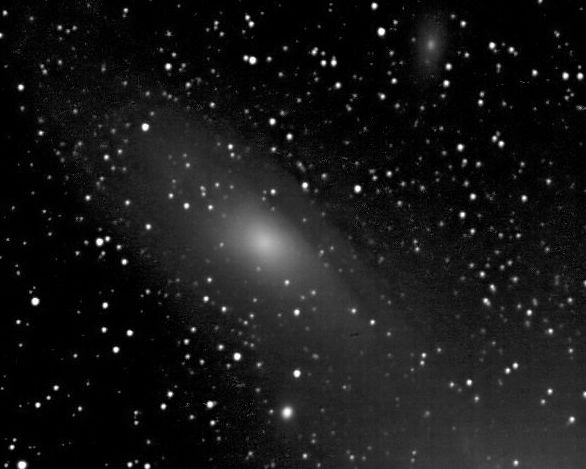
If the image is too faint on your monitor to see the fainter parts of the galaxy, move your mouse over the image to see a version with the gamma increased further.
Date and Time: 20-21st September 2006 23:42 to 00:54 UT
Camera: Atik ATK-1HS
Telescope: 135 mm SLR at f/6.3
Capture: K3CCDTools. Low gamma, B/W, 90, 60, 30, and 15 seconds, 100% gain, 16-26 frames and 5 dark frames
Processing: K3CCDTools for each AVI, final images combined in Registax.
PhotoImpact. Gamma 2.0, brightness -25.
NeatImage to reduce noise.
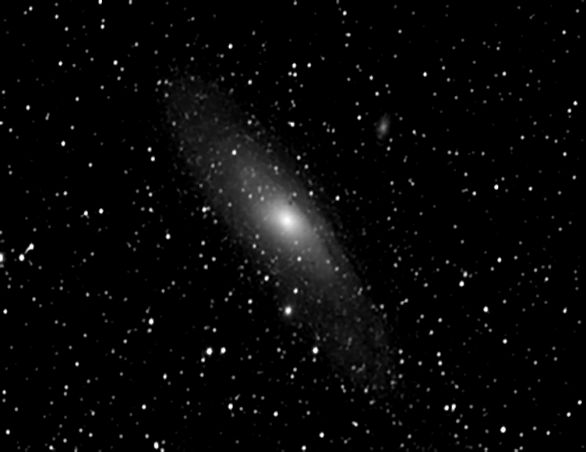
I am making progress. This picture was taken under far from ideal conditions, there was light cloud about and the atmosphere was hazy. This image was made with the same lens as the picture above but at f/4 (i.e. a 34 mm telescope) and using my MX716 camera which has a bigger sensor. A skyglow filter was not sufficient to cut through the light pollution, so I used my narrow-band SII filter. The downside of this was that I had to use 10 minute exposures, and I only got seven frames before the clouds came in, and I used only three of these in the final stack.
Date and Time: 1st January 2010 19:10 to 20:10 UT
Camera: Sartlight Xpress MX716
Telescope: 135 mm SLR at f/4 and SII filter
Capture: star_mx7, 600 seconds, full resolution
Processing: star_mx7: background, non-linear stretch power 25, background.
Irfanview: conversion to png format.
Registax5: stacked 3 frames, gamma 1.5, histogram 20-255
Photoimpact: (gaussian blur 2, focus magic 4,100) twice, unsharp mask factor 20, radius 10.
Registax: histogram 15-255
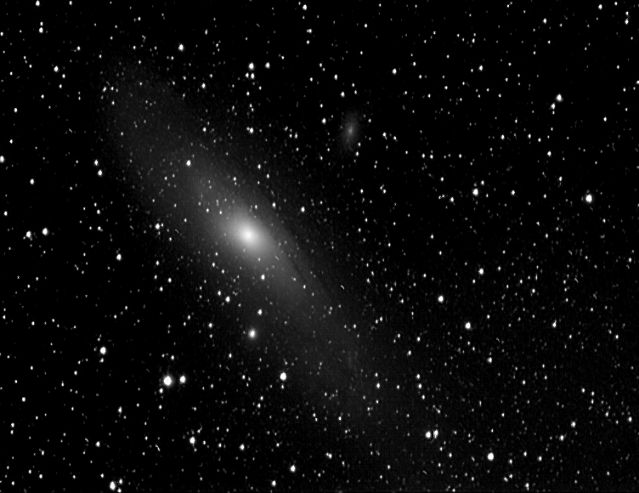
Much better conditions two nights later. This picture was taken through a commercial IR-pass filter (λ>685 nm) because, again, a skyglow filter was insufficient to cut out the pollution well enough for this faint object.
Date and Time: 3rd January 2010 21:53 to 22:16 UT
Camera: Sartlight Xpress MX716
Telescope: 135 mm SLR at f/4 and IR-pass filter
Capture: star_mx7, 60 seconds, full resolution, 23 frames
Processing: star_mx7: background, non-linear stretch power 25, background.
Irfanview: conversion to png format.
Registax5: stacked 23 frames, wavelets 1-2 = 5, gamma 1.3, histogram 10-255
PhotoImpact: unsharp mask radius 2 factor 50.
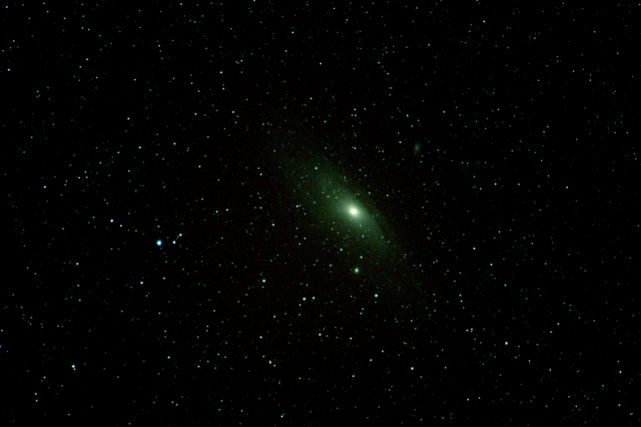
Try as I will I have never got a picture of M31 that I am pleased with. Whilst taking pictures of constellations using my Canon 1000D DSLR camera, I fitted it with a 300 mm lens and pointed it at M31. Two minutes was the longest exposure I used as the light pollution gave a bright red glow over all the picture. However, with a lot of processing to remove the red background and increase the gamma and the contrast, I managed to extract this picture from it.
Date and Time: 18th August 2010 22:21 UT
Camera: Canon 1000D
Telescope: 70-300 mm USM at f/5.6
Capture: 120 seconds
Processing: PhotoImpact: Colour adjustment to remove the background, contrast, brightness and gamma increased in steps with further colour adjustment.
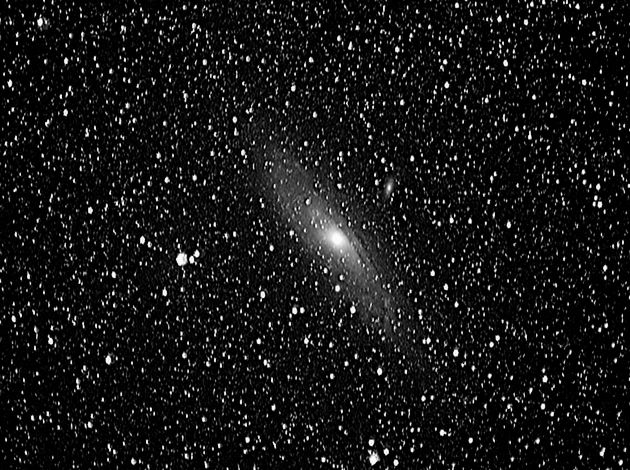
"—it's full of stars!" - David Bowman 2001
This attempt as taken with my MX716 camera and Zenit 58mm SLR lens at f/4. What surprises me in this picture is the number of stars. The galaxy is close to but not within the plane of the Milky Way. To some extent the appearance is enhanced by the extreme processing that I have to do to bring out the galaxy itself.
Date and Time: 1st September 2011 01:47 - 02:11 UT
Camera: Starlight Xpress MX716
Telescope: 58-mm SLR at f4 and Astronomik CLS filter
Capture: star-mx7 10 frames @ 60 sec, 5 frames @ 120 seconds
Processing: star-mx7: dark-frame subtraction, non-linear stretch 25, background subtraction.
Irfanview: conversion to png format.
RegiStax6: each set stacked and enhanced with gaussian wavelet Scheme 1, then the two pictures combined.
Focus Magic 2,100
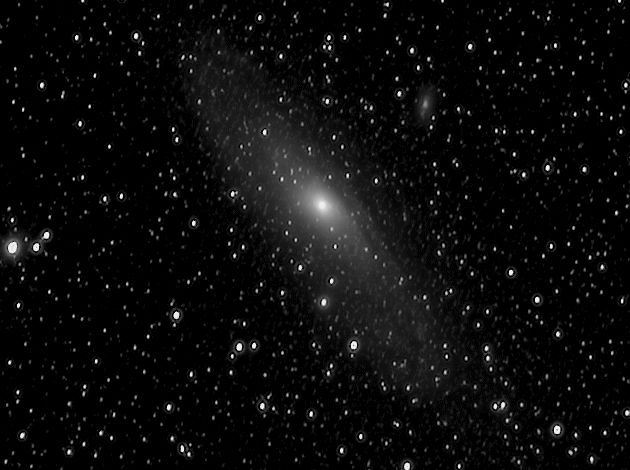
I was quite pleased with the above picture so I decided to try again with my ×2 lens added to the 50-mm lens. This is a combination I have never used before (preferring the single 135-mm lens rather than a combination that gives me 116 mm f/8). I have failed to get the contrast that I had above. (For comparison I have put a ×2 enlargement of the image above in a mouseover.) To me the amazing thing about this image is that I was able to use a 5-minute exposure with a CLS filter without local light pollution flooding the image. It must have been a very clear night, but I still don't have the contrast. I only managed 7 frames before clouds intervened.
Date and Time: 24th September 2011 21:59 - 22:30 UT
Camera: Starlight Xpress MX716
Telescope: 58-mm SLR at f4 with ×2 lens (gives 116 mm f/8) and Astronomik CLS filter
Capture: star-mx7 7 frames @ 300 seconds
Processing: star-mx7: dark-frame subtraction, non-linear stretch 25, background subtraction.
Irfanview: conversion to png format.
RegiStax6: gaussian wavelet Scheme 3.
Focus Magic 2,100
PhotoImpact gamma 1.4, brightness -17.
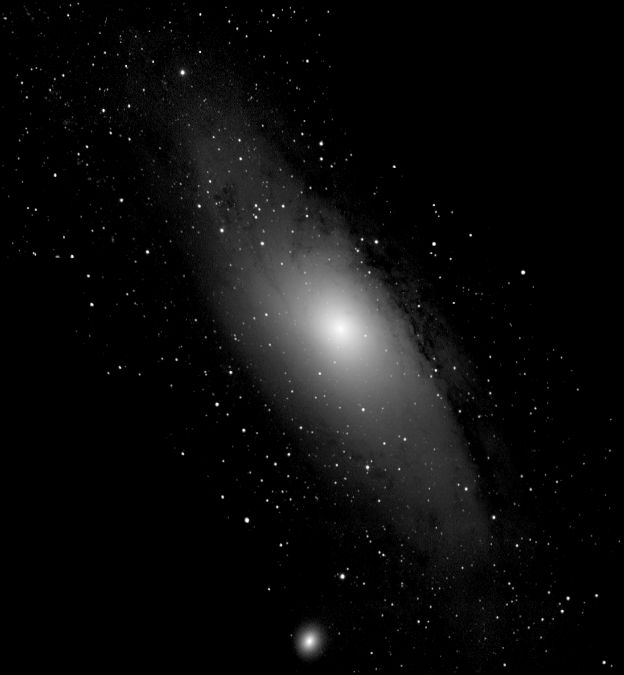
Finally I decided it was time to use my LX200 and try constructing a mosaic. This picture is a mosaic of five 60-second exposures at prime focus using a CLS filter. I think the results are promising, and at least it resolves M32 which I have never been able to distinguish with shorter focal-length lenses. (It is the fuzzy object at the bottom of the picture.)
Date and Time: 29th September 2011 22:35 - 22:45 UT
Camera: Starlight Xpress MX716
Telescope: LX200 and Astronomik CLS filter
Capture: star-mx7: 6 frames @ 60 seconds
Processing: star-mx7: dark-frame subtraction, non-linear stretch 25, background subtraction.
Irfanview: conversion to bmp format.
iMerge: construction of mosaic.
PhotoImpact: gamma 1.5, contrast 4. Focus Magic 1, 100
Home Back to DSOs